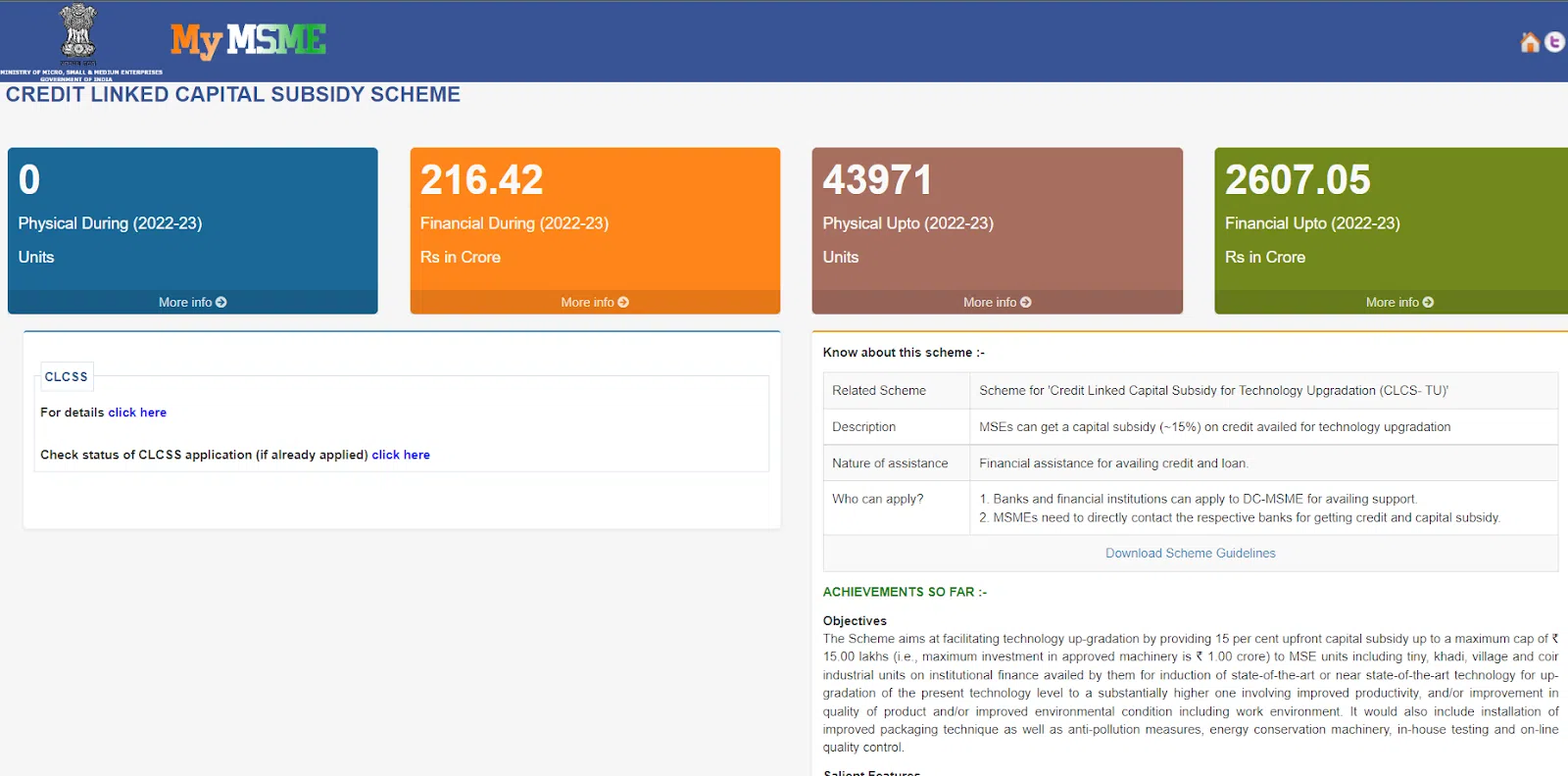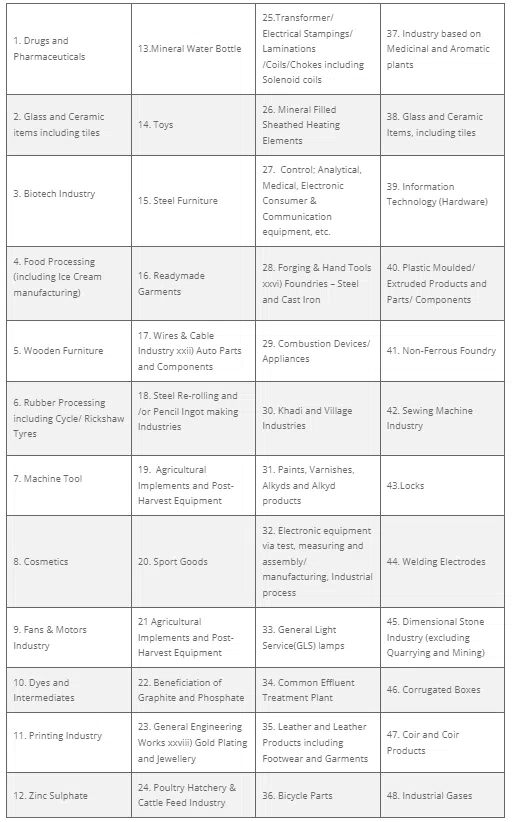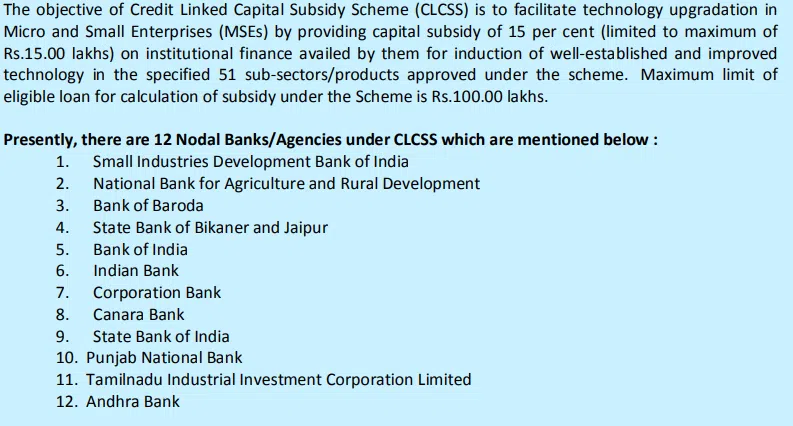The Credit linked capital subsidy scheme (CLCSS) and the Technology Upgradation theme (CLCS-TUS) for Small and Medium Enterprises (MSEs) are devised by the government. The Credit connected Capital grant theme, or CLCSS, intends to assist SSI units.
Due to scarcity of investment and awareness of quality criteria, several SSI units still use obsolete technology, machinery and equipment. Due to competition, the enlargement and development of SSI units rely on improvement and technical improvement. Small corporations should prioritise improving their production processes so that their sales are skyrocketing with premium quality.
Do you know?
The Credit Linked Capital Subsidy Scheme intends to benefit MSME and SSI firms such as khadi, rural, industrial coir, and micro-enterprises from technical improvement by offering capital subsidies. Infrastructure and machinery upgrades will improve the industry’s competitiveness, allowing it to offer lower-cost goods and services.
What Is a Credit Linked Capital Subsidy Scheme?
The Credit Linked Capital Subsidy Scheme (CLCSS) is run by the Ministry of Small Scale Industries (SSI) to help small businesses upgrade their equipment. The Scheme aims to assist SSI units, such as small, khadi, rural, and coir industrial units, in modernising their production equipment by providing upfront capital subsidies on financial institutions (credit) (plant and machinery). The Scheme offered SSI units, including micro-units, a 15% capital subsidy on institutional investment to introduce well-established and upgraded technology in defined sub-sectors/products recognised by the Scheme.
CLCSS Scheme Benefits for Technology Upgradation
A technology upgrade entails transitioning from present technology to cutting-edge technology beneficial for productivity, improving conditions for the environment, improving product quality, and improving work done around the unit. Below are the pros of the CLCSS Scheme:
- It helps upgrade the technology of small-scale industries that belong to different products/sectors as covered in the MSME Ministry.
- It provides a 15% subsidy for purchasing plant equipment & machinery. This helps in decreasing the loan burdens of small micro and enterprises.
- It supports the growth of rural industries by providing them with enough capital to manufacture high-quality products.
CLCSS can help you upgrade your small-scale industry’s equipment and machinery. Opt for the CLCSS’s subsidies to modernise your plant’s equipment and machinery. Before applying for a term loan, ensure that the CLCSS program covers your principal lending from the institution.
Eligibility For CLCSS
- The scheme’s capital subsidy of 15% on qualified plants and machinery will be available only for projects that have been approved for term loans by an eligible PLI.
- Industries that are transitioning from small-scale to medium-scale because of the sanction of an additional loan under the CLCSS scheme are also eligible for assistance.
- The scheme’s capital subsidy eligibility is unrelated to any refinancing scheme for nodal agencies.
- This plan will consider new export-oriented and labour-intensive sectors/activities.
How Can I Apply for the CLCSS Scheme?
An online application and monitoring system was established in 2013. Eligible MSMEs can apply online for subsidies under the Credit Linked Capital Subsidy Scheme through PLIs (Primary Lending of Institutions) from which they acquire term loans. The PLI submits an online application and keeps an eye on the system to the linked agency for nodals, which forwards the application to the Office mode to DC for subsidy payout. Following the processing of the application and the availability of money, with the IFW full form (Internal Finance Wing), the CA (Competent Authority) gives authorisation, and monies are allocated to the Nodal Agencies.
Documents Required For CLCSS Scheme
- Aadhar card / PAN card / Voter ID
- Address proof
- Business proof
- Recent photographs
- KYC documents
Some of the Industries and Products that Potentially Profit from the CLCSS Scheme Include
Industries
- Dyes and intermediates
- Food preparation; Corrugated boxes;
- Rubber processing, particularly bicycle and rickshaw tyres;
- Biotechnology industry;
- Pharmaceuticals and medications;
- Plant for Effluent common Treatment; Cattle Feed Poultry Hatchery and Industry;
- Industry based on aromatic and therapeutic plants;
- Products, components or parts made of plastic that have been moulded or extruded
Products
- Glass and Ceramic Items, including tiles
- Toys
- Mineral Filled Sheathed Heating Elements
- Food Processing (including Ice Cream manufacturing)
- Readymade Garments
- Steel Furniture
- Control, Analytical, Medical, Electronic Consumer and Communication equipment
- Forging & Hand Tools Foundries – Steel and Cast Iron
- Wires & Cables
- Auto Parts and Components
- Wooden Furniture
- Sewing Machine
- Locks
- Cosmetics
- Sports equipment
- Welding Electrodes
Credit Linked Capital Subsidy Scheme Nodal Agencies and Banks
The SIDBI (Small Industries Development Bank of India) and the NABARD executed the CLCSS subsidy (National Bank for Agriculture and Rural Development). National Small Industries Corporation Limited, Canara Bank, Andhra Bank, State Bank of India (SBI), and Bank of Baroda were the nine public sector banks and government institutions chosen as nodal agencies or banks for the scheme’s execution.
Eligible Beneficiaries
- Subsidies are accessible for brand new units registered with the State Board of Industries and have the relevant technology verified by GTAB or TSC.
- Units that are presently registered with the State Board of Industries are eligible to use for SSI sector upgrade.
- In the SSI sector, partnerships, public and personal restricted companies, co-operative societies, and individual proprietors and all eligible.
- The machinery non-inheritable underneath the NSIC’s purchase theme for hiring was eligible, as were export-related operations with a high labour intensity.
- The priority is given to women entrepreneurs.
Eligible Primary Lending Institutions
- Scheduled Commercial Banks
- SFCs or State Finance Corporations
- Scheduled Co-operative Banks
- NEFDI or North Eastern Development Financial Institution
- RRBs or Regional Rural Banks
The Procedure For Requesting For CLCSS
- The CLCSS has had an online application and tracking system since 2013. Eligible borrowers must apply for the CLCSS subsidy at Primary Lending Institutions (PLIs), where they have taken out term loans.
- The recipient will be asked to complete an application form provided by the PLI. The PLI uploads the completed application to the internet portal. The linked nodal agency receives the submitted application and recommends it to the Office of DC (MSME).
- The DC (MSME) office approves the subsidy disbursement following verification. The IFW delivers the monies to the Nodal Agencies when all requisite verifications have been completed.
Also Read: Small Scale Industries in India (SSI) – Registration, Types, Advantages & More
The CLCSS’s Highlights
- Businesses can get up to a 15% subsidy on qualified machinery investment under the CLCSS scheme (up to a maximum of ₹1 crore).
- Only enterprises that have invested in qualified plant machinery utilising term loans from the pre-approved list of PLIs are eligible for the 15% incentive (Public Lending Institutions).
- The subsidy is also available to industries transitioning from small to medium scale due to extra loans under the CLCSS scheme.
Conclusion
The system (pre-advised) provides a 12% capital subsidy to SSI units and small businesses on institutional financing (credit) that is used to introduce well-established and enhanced technology in authorised sub-products/sectors under the Credit Linked Capital Subsidy Scheme. The pre-revised program assessed the qualifying amount of subsidy based on a loan amount not exceeding ₹40 lakhs.
The Ministry of Micro, Small, and Medium Enterprises (M/o MSME) has launched a subsidy plan called Credit Linked Capital Subsidy Scheme (CLCSS full form) to help Micro and Small Enterprises (MSEs) upgrade their technology. This scheme’s main goal is to help Small Scale Industries (SSI) expand and flourish in rural and urban regions.
Follow Legal Tree for the latest updates, news blogs, and articles related to micro, small and medium businesses (MSMEs), business tips, income tax, GST, salary, and accounting.









